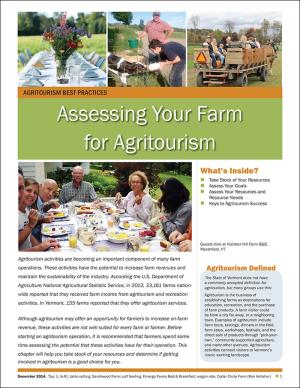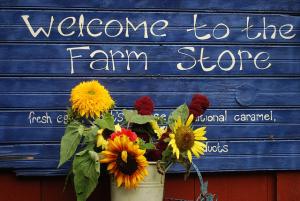What a great project, and the resulting guides are wonderful! I'm so excited to see how the industry grows and changes in the future!
Agritourism Guides for Farmers
Agriculture and tourism are both vibrant contributors to Vermont’s economic and cultural landscapes. Agritourism blends the two industries through offerings such as on-farm dinners, farm stands, harvest festivals, on-farm weddings, and more. With rising consumer interest, more Vermont farmers are thinking creatively about how they can engage customers in activities on their farms. Now they’ll have several new resources to guide them (see sidebar), thanks to a project coordinated by the Vermont Farms! Association in collaboration with partners.
The project began in 2013 with focus groups and one-on-one conversations to help identify high-need topics for farmers. I spent the next exhilarating year gathering input from farmers and agricultural service providers about the shape the resource guides should take and the content to include.
All the farmers I spoke with were so generous in sharing their experiences, in hopes that the next crop of farmers could avoid their mistakes and share the rewards. Lessons were embedded in stories about marketing pitfalls, friendships formed, animals lost, and all sorts of storms that were weathered. My favorite stories involved agritourism customers, often families who were trying something for the first time, whether it was a dollop of maple syrup on a spoon or the experience of hand-milking a cow.
When I mapped the project out, I never could have anticipated how fun it would be to drive to all corners of the state to experience agritourism events. My research took me to Agape Hill Farm, a fiber arts studio and animal rehabilitation program in Hardwick; Fat Toad Farm, a farm stand and caramel production facility in Brookfield; Green Mountain Girls Farm in Northfield, to attend a chevre making class; and Flack Family Farm in Fairfield for a community kimchi-making day. Then there were all the open houses, festivals, burger nights and other events!
All of the information was folded into thirteen guides, released in January 2015, and now available on UVM Extension’s new agritourism website.Across Vermont, about 155 farms currently offer agritourism opportunities (if you include participation in farmers’ markets, that number jumps to over 2,000). While offerings are diverse, these farmers have a common understanding that agritourism can connect their customers with the story behind their farm’s products, with real economic benefits to both their farms and their communities. As Beth Kennett, owner of Liberty Hill Farm and Inn in Rochester says, she spends around $40,000 annually at the local grocery store, and when she sees a new employee there, she knows that employers can hire their neighbors because of customers like her. This is a ripple effect, in which economic benefits spread from one local business to the next.
The guides drew on the wisdom of farmers young and old, beginners and veterans. Veterans like Beth Kennett, Lee Light of Hollister Hill Farm in Marshfield, and Pam Allen of Allenholm Farm in South Hero have been joined by newer entrepreneurs such as Mari Omland and Laura Olsen of Green Mountain Girls Farm, and Kim Goodling of Vermont Grand View Farm in Washington, a fiber farm that hosts summer camps, farm stays, and retreats.
Collectively, they paint a promising, yet realistic picture of what agritourism entails. Farmers who are considering whether it’s a path for them have a whole chapter dedicated to helping them make that decision (see Assessing Your Farm for Agritourism).
Here are a few more words of wisdom from some of Vermont’s farmer-leaders in agritourism:
“Running a PYO is a dance, where you are trying to keep the farm’s health and the customers’ experience in balance.”
Adam Hausmann, Adam’s Berry Farm, Charlotte, VT , from How to Develop a Pick-Your-Own Business
“We clean up enough to be safe, but not enough to hide what we do. It’s important to show people what real farming is.”
Scout Proft, Someday Farm, East Dorset, VT, from How to Develop a Farm Tour
"Define success however it befits your personality, ethos, etc. But, remember, if it won’t make money, then it won’t survive — and that benefits no one. So, what does success mean to you?”
Scott Woolsey, Retail and Customer Service Manager, Killdeer Farm and Farm Stand, Norwich, VT , from How to Develop a Farm Stand
Scott’s question is possibly the most important and most challenging question that farmers will have to answer as they embark on their adventures in agritourism. And while there is a lot of information in the guides, that is one answer farmers will have to come up with on their own.


